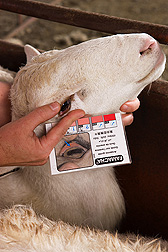Integrated Worm Control in Lambs
The blood-sucking barber pole worm, Haemonchus contortus, costs livestock producers millions of dollars in losses worldwide. Animals shed worm eggs in their manure, and the larvae that hatch can be consumed by other grazing livestock, continuing the harmful cycle.
Deworming is an important management tool, but unnecessary deworming is costly and can speed the development of parasiticide resistance in the worms. Deworming of lambs can be minimized by the use of rotational grazing and by checking the animals’ inner eyelid color for signs of anemia, according to Agricultural Research Service scientists and cooperators.
Animal scientist Joan Burke of ARS’s Dale Bumpers Small Farms Research Center in Booneville, Arkansas, and colleagues collaborate with scientists, veterinarians, and extension agents from the Southern Consortium for Small Ruminant Parasite Control. The consortium was formed in response to the threat posed by worms that have developed resistance to parasiticides.
“Using alternatives to conventional parasiticides fits well into organic and grass-fed management systems and meets consumer preferences of minimizing chemical residues in the meat,” says Burke.
The researchers used a tool called “FAMACHA” to determine whether to deworm their study animals. They compared the lambs’ eyelid color with FAMACHA photos of the eyelids of sheep at five levels of anemia. The stages range from the red eyelids of healthy livestock (Stage 1) to almost white eyelids of severely anemic livestock (Stage 5).
FAMACHA is named after its developer, South African livestock parasitologist François “Fafa” Malan, and is used by farmers or ranchers to determine when to deworm their animals.
In a study that involved 71 lambs naturally infected with the barber pole worm, deworming was only done to those that reached FAMACHA Stage 3. The researchers used an alternative dewormer—a gel capsule filled with copper oxide wire particles. Only one lamb did not respond to the copper oxide and required the conventional treatment. Nineteen lambs did not need any deworming.
|
|
Rotational Grazing Helps
Some of the lambs grazed on bermudagrass in the same pasture all season, and some were rotated to a different pasture every 3.5 to 7 days. They returned to the initial pasture 28 to 35 days later and three times over the 105-day grazing season. The lambs that rotated pastures needed fewer dewormings.
“This is the first study of rotational grazing that used lambs that had worms,” Burke says. “This is the only way you can find out whether rotational grazing has any advantages over continuous grazing for organically managed animals.”
Rotational grazing may prevent animals from concentrating worm larvae because they are not bedding down in the same area every night. Also, neither pasture was overgrazed, an important consideration in both minimizing reinfection of livestock and maintaining healthier pastures.
This work was published in the July 7, 2009, issue of Veterinary Parasitology.—By Don Comis, Agricultural Research Service Information Staff.
This research is part of Animal Health (#103) and Pasture, Forage, and Range Land Systems (#215), two ARS national programs described at www.nps.ars.usda.gov.
Joan M. Burke is with the USDA-ARS Dale Bumpers Small Farms Research Center, 6883 South State Hwy. 23, Booneville, AR 72927-8209; (479) 675-3834, ext. 227.
"Integrated Worm Control in Lambs" was published in the July 2010 issue of Agricultural Research magazine.








